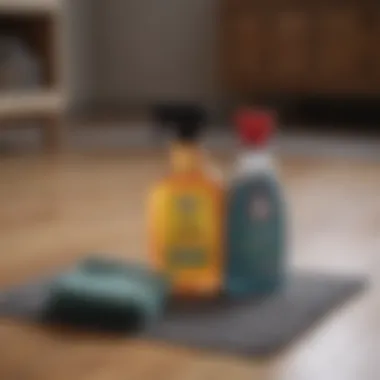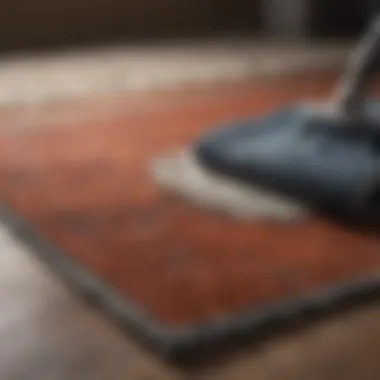Expert Techniques for Cleaning Small Rugs at Home


Intro
Cleaning small rugs at home can feel like an uphill task, yet it need not be overwhelming. Small rugs serve functional and aesthetic roles in our living spaces. Learning how to clean and maintain them properly will enhance not only their longevity but also the overall character of your home.
In this guide, we will explore effective cleaning methods tailored for various materials. Each rug has its own nuances, and understanding these will lead to smarter choices. We will cover cleaning supplies you may need, techniques for tackling stains, and ways to keep your rugs looking fresh and vibrant.
Maintaining small rugs is essential for preserving their integrity while adding warmth and texture to your home.
Home Features
Architectural Influences
A well-designed home can boast structural features that highlight the beauty of small rugs. Architectural elements such as large windows or open floor plans interact with rugs in a unique way. These small pieces of fabric become focal points, showcasing color schemes and styles throughout the space.
Unique Design Elements
Small rugs can add character to your space. They can define areas, cushion foot traffic, and even absorb sound. Be it a vibrant print in a neutral room or a subtle tone that complements other decor, small rugs play a crucial role. Choosing the right rug involves considering color, texture, and placement.
Cleaning Methods
Basic Upkeep
Regular maintenance is vital in keeping small rugs in top shape. Here are a few suggestions:
- Vacuuming: Regularly vacuum to pick up dirt and debris. Make sure to use a vacuum with a suction-only mode to avoid damaging delicate fibers.
- Rotate Rugs: Every few months, rotate your rugs to ensure even wear and fading.
- Spot Cleaning: Address spills immediately with a damp cloth to prevent stains from setting.
Stain Removal Techniques
Stains can happen despite caution. A simple approach can often save a rug. Here's what you can do:
- Dabbing: Always dab a stain with a clean cloth or paper towel. Avoid rubbing, which can damage fibers.
- Mild Detergent: Use a mixture of mild detergent and water for tougher stains. Test in a small area first.
- Natural Solutions: Options like vinegar or baking soda may work well for specific stains, but be sure to check their compatibility with your rug's material.
Deep Cleaning
Deep cleaning can revive tired or stained rugs. Strategies include:
- Professional Cleaning Services: Consider hiring professionals for maximum effectiveness. They have tools and expertise specialized for various materials.
- Steam Cleaning: If you have a durable rug, steam cleaning might be suitable. However, ensure this method is safe for your rug type.
Maintenance Tips
- Protect from Sunlight: Prolong the life of your rug by minimizing sun exposure. Use curtains or blinds.
- Address High Traffic Areas: Place rugs in low-traffic areas or use larger rugs in frequently used spaces to reduce wear.
"A little care goes a long way in maintaining the beauty of your small rugs."
Ending
Cleaning and maintaining small rugs is not merely about aesthetics; it is also about preserving an important element of your home’s ambiance. The methods discussed can lead to improved longevity and visual appeal. By being proactive in care, you enhance the charm of your living space, keeps your rugs looking fresh.
The combination of systematic approaches and understanding your rugs gives you the right tools for a well-maintained home.
For further insights and discussions, check out resources like Wikipedia, Britannica, or communities on Reddit and Facebook.
Prologue to Cleaning Small Rugs
Cleaning small rugs at home is an essential aspect of maintaining a pleasant living environment. These adornments not only enhance the aesthetic appeal of a room but also contribute significantly to indoor comfort. Rugs accumulate dirt, dust, and allergens over time, making regular cleaning indispensable. This article delves into various cleaning techniques and methods tailored specifically to small rugs, ensuring they retain their beauty and function.
Understanding Different Rug Types
Rugs come in diverse materials and constructions, each with distinct cleaning requirements. Knowing these nuances is vital for effective maintenance. Below, we explore various rug types, their characteristics, and their respective advantages and disadvantages.
Natural Fiber Rugs
Natural fiber rugs are crafted from materials like wool, cotton, or jute. Their primary appealing characteristic is their eco-friendliness and durability. These rugs often add warmth and texture to interiors, making them a popular choice among homeowners. However, the unique feature of natural fiber rugs is their sensitivity to moisture. Exposure to water can cause warping or mildew, which poses a cleaning challenge. Despite this concern, their natural appearance and breathability are significant advantages in maintaining an inviting home atmosphere.
Synthetic Fiber Rugs
Synthetic fiber rugs, made from materials like nylon or polyester, are known for their resistance to stains and easy maintenance. These rugs are often chosen for high-traffic areas due to their durability and affordability. The key characteristic that sets synthetic rugs apart is their ability to mimic the look and feel of natural fibers while offering greater stain resistance. However, this durability may come at the expense of some environmental considerations, as synthetic materials are petroleum-based. Nonetheless, their practical benefits often outweigh these drawbacks.


Oriental Rugs
Oriental rugs are often handcrafted and feature intricate designs that reflect cultural artistry. Their notable characteristic is the quality of materials used, such as silk or wool, contributing to their luxurious appearance. These rugs typically serve as significant decorative pieces rather than everyday floor coverings. The unique feature lies in their artisan craftsmanship, which can be a wise investment for collectors or homeowners seeking to enhance their interior decor. However, their cleaning process may require extra caution and specialized methods to maintain their intricate patterns and color richness without damage.
Indoor-Outdoor Rugs
Indoor-outdoor rugs are specially designed to withstand both indoor and outdoor conditions. They are often made from durable, weather-resistant materials that do not fade easily. The key attribute of indoor-outdoor rugs is their versatility; they can spruce up a patio or a living room alike. However, while they are resistant to moisture, they may be more susceptible to dirt accumulation in certain environments. Keeping them clean enhances longevity and maintains their vibrant look.
The Importance of Regular Cleaning
Regular cleaning of small rugs cannot be overstated. It helps to preserve their integrity and prolong their lifespan. In addition to improving aesthetics, consistent care prevents the buildup of dust and allergens, which can affect air quality. Therefore, integrating a systematic cleaning routine is essential, ensuring these valuable home pieces remain in optimal condition.
"A clean rug not only enhances your home’s beauty but also supports a healthier environment."
Basic Cleaning Supplies
Cleaning small rugs effectively demands a strategic approach, and having the right supplies can make a significant difference. Using appropriate tools not only eases the cleaning process but also protects the integrity of the rug materials. It is necessary to choose cleaning tools and solutions that are compatible with the type of rug in question. This section elaborates on vital cleaning supplies needed for effective rug maintenance.
Vacuum Cleaners and Their Settings
A vacuum cleaner is an essential weapon in maintaining the cleanliness of small rugs. Not all vacuums are created equal, and it’s crucial to use one with adjustable settings. Many rugs, especially those with delicate fibers, can be damaged by excessive suction power. Opting for a vacuum cleaner with multiple height and suction settings allows for a customized cleaning experience.
For example, a lower suction setting is ideal for delicate rugs, while a higher setting can be effective on synthetic or more durable options. Utilizing the right vacuum setting can clean effectively while preventing wear and tear. In addition, using attachments designed specifically for rugs can enhance the cleaning efficiency.
Cleaning Solutions: Commercial vs. Homemade
When it comes to cleaning rugs, the choice of cleaning solution is significant. Several options exist, from commercial products to homemade solutions. Each carries its own benefits and considerations.
Understanding pH Levels
The pH level of a cleaning solution affects its interaction with different rug materials. Most rugs thrive best in neutral pH environments, typically around 7. Products with a high or low pH may lead to color fading or material degradation.
Popular commercial cleaners often indicate their pH levels on the label. Readers should seek options that promise neutrality. A robust understanding of pH levels can offer peace of mind, knowing the cleaner won’t harm their rug.
Choosing Safe Ingredients
Selecting safe ingredients is another crucial part of choosing cleaning solutions. Ingredients should break down dirt without damaging fibers. Commercial cleaners may sound appealing, but they often include harsh chemicals. Homemade solutions made from natural components like vinegar and baking soda are a beneficial alternative.
Homemade solutions allow full control over what’s applied to the rug. However, it is essential to test any solution in an inconspicuous area before applying it broadly. Finding a balance between safety and efficacy is key for successful rug cleaning.
Brushes and Tools for Rug Cleaning
Beyond vacuum cleaners and solutions, having the right brushes and tools enhances the cleaning process. Different brushes serve unique purposes based on rug types and stains.
Soft Brushes
Soft brushes are appropriate for daily dust removal and gentle spot cleaning. They gently lift dirt without damaging fibers. This makes them a popular choice for delicate rugs such as silk or wool. Using a soft brush not only refreshes the rug but also helps maintain its natural plushness over time.
Scrub Brushes
For tougher stains, scrub brushes may be necessary. They provide more friction, which assists in breaking down dirt and grime. It is wise to choose a brush with medium bristles to avoid snagging or pulling fibers. Ensure that the scrub brush is suitable for the specific rug material to prevent any permanent damage.
Mops
Mops can be valuable for cleaning larger areas of rugs, particularly those made with synthetic materials. When damp cleaned, they allow for a more extensive and deeper cleaning without over-saturating the material. Select a mop that effectively captures debris while offering gentle flexibility.
By considering these basic cleaning supplies, homeowners can maintain their small rugs effectively while extending their lifespan. Prioritizing the right tools ensures that cleaning efforts yield satisfactory results.
Daily Maintenance Practices
Maintaining small rugs is essential to keep their beauty and functionality. Regular upkeep ensures longevity and reduces the frequency of deep cleaning, which can be labor-intensive. Daily maintenance practices include vacuuming and immediate spot cleaning, both of which play a critical role in preserving the rug's condition. Implementing these practices not only helps maintain the aesthetic appeal of the rugs but also contributes to the overall hygiene of the living space.
Regular Vacuuming Techniques
Regular vacuuming is a cornerstone of rug maintenance. It helps remove dirt, dust, and debris that accumulate over time. For small rugs, vacuuming should occur at least once a week. Use the upholstery attachment and adjust the vacuum settings according to the type of rug fiber. This ensures thorough cleaning without causing damage. Avoid using beater bars on delicate fabrics, as they can cause fraying or pulling. Effective vacuuming thus prevents dirt from embedding into the fibers, resulting in a cleaner and fresher rug.


Spot Cleaning Minor Stains
Spot cleaning is essential for addressing stains promptly. The quicker one acts, the better the chance of preventing permanent damage. Immediate attention to spills and stains is critical for maintaining the rug's color and texture.
Immediate Response to Spills
Taking action immediately when a spill occurs is vital. This approach minimizes staining and prevents the spill from settling into the fibers. The key characteristic of immediate response is quick action. By using a clean cloth or paper towel to blot the area, rather than rubbing it, one can absorb excess liquid without forcing it deeper into the rug. This method is beneficial because it reduces the risk of spreading the stain or damaging the rug's fibers.
Always remember: Blot instead of rub. This technique is your first line of defense against tough stains.
While immediate response requires speed, it also involves using the right cleaning solution. A gentle cleanser made from household ingredients often works best, allowing for effective cleaning without harmful chemicals that could cause color fading or fabric degradation. This rapid response is particularly advantageous when dealing with perishable spills like wine or juice.
Using Absorbent Materials
Utilizing absorbent materials is another important strategy in spot cleaning. When a spill occurs, using materials such as clean towels, cloths, or specialized absorbent pads can help soak up liquids effectively. The key characteristic of these materials is their capacity to take in moisture without leaving residues.
Absorbent materials are popular choices because they come in handy for a variety of spills. They allow for a more thorough initial clean, drawing moisture that could otherwise lead to deeper stains. Unique features include their ability to be reusable when washed properly, reducing waste and costs associated with disposable options. However, it's essential to ensure that any used absorbent material is clean to avoid transferring dirt back onto the rug.
Deep Cleaning Methods
Deep cleaning is an essential process that goes beyond the regular maintenance of small rugs. This method effectively removes embedded dirt, allergens, and stains that routine cleaning cannot. Understanding deep cleaning techniques can prolong the life of your rugs and keep them looking fresh and vibrant.
Preparing for Deep Cleaning
Clearing the Area
Clearing the area where the rug is located is a critical first step before diving into deep cleaning. This process involves moving furniture and any objects that could impede your cleaning efforts. It not only provides ample space to work, but it also prevents damage to surrounding items. A clear area helps you focus on the rug itself, ensuring no detail is overlooked. Removing potential hazards allows for safer and more effective cleaning.
Benefits of this practice include:
- Ease of Access: With an unobstructed area, it is easier to vacuum and thoroughly clean both sides of the rug without interference.
- Maintaining Order: Keeping the area tidy helps in organizing the cleaning process.
However, one must be cautious. Moving heavy furniture might require help from others or tools to minimize risk of injury or damage.
Testing Cleaning Solutions
Testing cleaning solutions on a small, inconspicuous area of the rug is another crucial preparatory step. This action assesses whether the solution will be safe and effective for the fabric of the rug. Choosing the right cleaning solution is key, as some products may cause discoloration or damage to certain rug materials.
The primary advantage of testing is that it allows for an informed decision. It provides insight into how the solution will interact with the fibers, giving you the chance to make adjustments if necessary. Should the initial choice react poorly, you can opt for alternatives that are more suited for the material.
However, testing can sometimes lead to misleading results, especially with rugs made from blends of fibers. Therefore, patience and care are important during this process.
Shampooing Small Rugs
Shampooing offers a deep clean that helps remove stubborn stains and odors. For the most effective results, always use a shampoo specifically designed for your rug type. Begin by vacuuming to get rid of loose debris. Once the rugs are prepped, apply the cleaner across the surface, working it into the fibers with a soft brush. Avoid saturating the rug, as excess water can lead to mold growth. Rinse thoroughly and allow to dry completely.
Steam Cleaning Essentials
Steam cleaning provides another robust method for deep cleaning small rugs. It utilizes high-temperature steam to penetrate and lift dirt from the fibers. The benefits of this include sanitization, as the heat effectively kills bacteria and allergens. Like shampooing, always vacuum before starting this process to achieve the best results.
The steam cleaning process generally involves:
- Preparing the Steam Cleaner: Fill it with water and allow it to reach the appropriate temperature.
- Applying Steam: Glide the machine over the rug slowly, letting the steam do its job without soaking the fibers.
- Drying: Ensure the rug dries completely to prevent moisture-related issues.
By implementing these deep cleaning methods, you can significantly enhance the longevity and aesthetics of your small rugs.
Special Considerations
When cleaning small rugs, several special considerations must be taken into account. These factors ensure not only effective cleaning but also the preservation of the rug's texture and color. Different rug types require varying methods and materials, and understanding this is crucial. Special considerations can prevent unintended damage and extend the lifespan of your prized rugs.
Cleaning Delicate Fabrics
Delicate fabrics, such as silk or fine wool, demand particular attention during the cleaning process. The fibers in these materials are often more susceptible to damage from harsh cleaning agents and aggressive scrub techniques.


- Gentle Handling: When cleaning delicate rugs, it's key to use minimal pressure. A soft brush or a gentle cloth is preferable.
- Appropriate Products: Always opt for pH-balanced cleaning solutions that do not contain harsh chemicals. Testing a small area first can prevent color bleeding or other damage.
Takes time to understand the material composition. This effort can keep the rug looking new and vibrant for longer.
Handling Antiques or Vintage Rugs
Antiques or vintage rugs hold significant value, both financially and sentimentally. Their care requires thoughtful methods to maintain their integrity and appearance.
Consulting Professionals
Consulting professionals for cleaning these rugs is often a wise choice. Experts have training and experience in dealing with various rug types, especially those made from delicate materials.
- Key Characteristic: They understand the appropriate techniques for each fabric type, preventing damage that could occur from improper cleaning.
- Beneficial Choice: Many professionals use specialized equipment and cleaning solutions.
- Unique Feature: They can also identify repairs and restorations that may be needed.
Though employing professionals can be more costly, it usually results in a safer and more effective cleaning.
Using Gentle Techniques
Using gentle techniques is pivotal when handling vintage rugs. Scrubbing too hard or using the wrong cleaning solutions can ruin intricate patterns and fade colors.
- Key Characteristic: Gentle techniques focus on preserving the artistry and details in these rugs.
- Beneficial Approach: Methods such as light dampening and air drying help maintain their pattern and texture.
- Unique Feature: Applying these techniques requires careful observation of the rug's condition throughout the process.
With gentle techniques, you ensure that the beauty of your antique or vintage rugs remains unblemished.
Maintaining the condition of small rugs, especially delicate or vintage ones, requires both knowledge and careful approaches. It is important to be mindful of the cleaning methods used.
Post-Cleaning Care
After completing the cleaning process, post-cleaning care is essential to maintain the durability and visual appeal of small rugs. Following proper care techniques ensures that the rug remains in good condition for an extended period. Neglecting post-cleaning processes can lead to mold growth, fading, and even irreversible damage.
Understanding the right techniques and tools to use during this phase can contribute positively to the longevity of your rugs. Some benefits to consider include preserving colors, enhancing softness, and prolonging the life of the fibers. Since rugs can be a significant investment, incorporating effective post-cleaning habits is a prudent choice.
Drying Techniques
Avoiding Direct Sunlight
One crucial aspect of drying rugs is avoiding direct sunlight. Sunlight can cause colors to fade or even cause the fibers to become brittle. For those who value the aesthetic quality of their rugs, this is an important consideration.
The key characteristic of avoiding direct sunlight is that it helps retain the original colors and integrity of the material. This practice is popular among rug owners who want to keep their investment in the best possible condition. A unique feature of avoiding such drying methods is that it helps in maintaining moisture levels in the rug fibers, preventing them from drying out too quickly. The main advantage here is certainly preserving the vibrant colors and durability while extending its lifespan.
Using Towels for Faster Drying
Using towels is another effective method for speeding up the drying process of small rugs. Towels can absorb substantial moisture from the rug, leading to quicker drying times. This method also minimizes the chances of mildew growth that can come from prolonged dampness.
The key characteristic here is the efficiency of absorption, which makes this method beneficial for a quick turnaround after cleaning. A unique feature of using towels is that you can choose different types of towel materials, each with varying absorbency levels. An advantage of this practice is its ease of execution; it requires simple materials that are often readily available at home. However, over-wetting the rug while using towels can be a disadvantage if not done correctly, which reinforces the need for cautious handling.
Regular Maintenance Follow-Up
Regular maintenance follow-up is crucial to ensure the long-term care of your rug post-cleaning. This involves creating a schedule for vacuuming, spot cleaning, and deep cleaning based on usage and environment factors.
By keeping track of maintenance routines, any potential issues can be addressed before they escalate. This practice not only enhances the appearance of the rug but also contributes to a healthier living space. Regular attention can safeguard against dirt buildup and ensures your small rugs continue to be a welcome addition to your home.
End
Summarizing Key Practices
To effectively clean small rugs, it is crucial to adopt a systematic approach. Here are the key practices that one should consider:
- Regular Vacuuming: This should be a frequent task to prevent dust and debris buildup. Employing the correct vacuum settings for different rug types ensures thorough cleaning without damage.
- Spot Cleaning: Immediate attention to spills and stains can prevent permanent damage. Using absorbent materials can effectively address minor issues before they set.
- Deep Cleaning Methods: Engage in periodic deep cleaning, utilizing appropriate methods such as shampooing or steam cleaning based on the material of the rug.
- Post-Cleaning Care: Make sure to dry rugs properly and follow up with maintenance routines to keep them looking new.
By consolidating relevant practices, individuals can maximize the lifespan and appeal of their small rugs.
Encouragement for Careful Rug Maintenance
Caring for small rugs is not just about cleaning; it is about establishing a routine that respects the materials and craftsmanship involved in their creation. Investing time and effort in routine maintenance can yield significant rewards in the long run. With proper care, your rugs can remain luminous and maintain their structural integrity, allowing them to enhance the aesthetic of your space for years.
Recognizing the value in careful rug maintenance can inspire a deeper appreciation for these textile art forms. Whether the rug is a cherished family heirloom or a recent purchase, every piece deserves attention. Reinforcing these habits encourages an overall culture of cleanliness and respect at home, ultimately benefiting not just the rugs, but the environment in which they exist.
"A little maintenance goes a long way in preserving the charm of small rugs."
For a comprehensive view of the methods available for maintaining your rugs, consider the tips and insights offered here as a roadmap to success.



